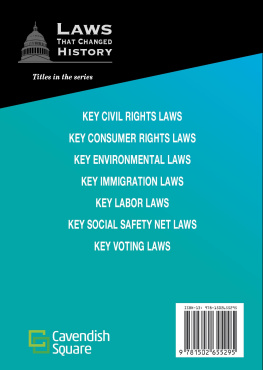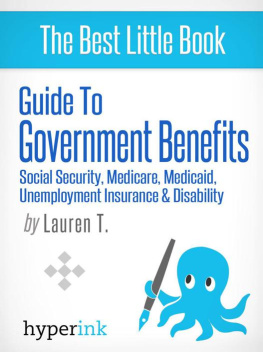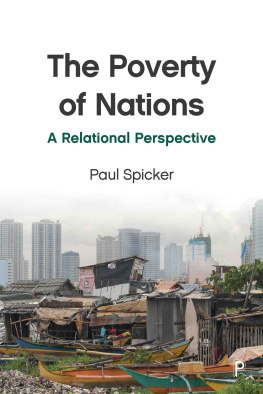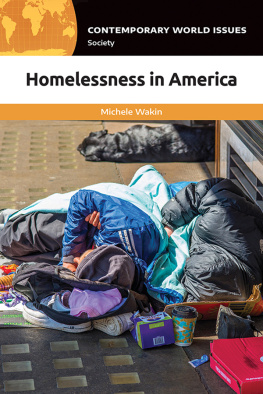
Published in 2020 by Cavendish Square Publishing, LLC
243 5th Avenue, Suite 136, New York, NY 10016
Copyright 2020 by Cavendish Square Publishing, LLC
First Edition
No part of this publication may be reproduced, stored in a retrieval system, or transmitted in any form or by any meanselectronic, mechanical, photocopying, recording, or otherwisewithout the prior permission of the copyright owner. Request for permission should be addressed to Permissions, Cavendish Square Publishing, 243 5th Avenue, Suite 136, New York, NY 10016. Tel (877) 980-4450; fax (877) 980-4454.
Website: cavendishsq.com
This publication represents the opinions and views of the author based on his or her personal experience, knowledge, and research. The information in this book serves as a general guide only. The author and publisher have used their best efforts in preparing this book and disclaim liability rising directly or indirectly from the use and application of this book.
All websites were available and accurate when this book was sent to press.
Cataloging-in-Publication Data
Names: Acks, Alex.
Title: Key social safety net laws / Alex Acks.
Description: New York: Cavendish Square Publishing, 2020. | Series: Laws that changed history | Includes glossary and index.
Identifiers: ISBN 9781502655325 (pbk.) | ISBN 9781502655332 (library bound) | ISBN 9781502655349 (ebook)
Subjects: LCSH: Public welfare--Law and legislation--United States--Juvenile literature. | Welfare recipients--Legal status, laws, etc.--United States--Juve-nile literature. | Welfare recipients--Medical care--Government policy--United States--Juvenile literature.
Classification: LCC KF3720.A93 2020 | DDC 344.730316--dc23
Printed in the United States of America
Photo Credits: Cover, p..
CONTENTS
Introduction
A t the end of 2018, President Donald Trump demanded $5.7 billion in funds to build a wall between the United States and Mexicoa project that was unpopular with most Americans at that time. The Republican-controlled House of Representatives refused to vote on a government funding bill the Senate had passed because it did not include money for the wall; without funding, on December 22, 2018, the federal government ran out of money to run nine of its departments.
Immediately, more than 800,000 people employed by the federal government could not be paid. About 380,000 of them were furloughed: They were told to go home and not return to work until there was funding. The other 420,000 workers were forced to continue working with no idea of when their next paycheck would come. The shutdown affected even more people indirectly. Government janitors lost pay because the buildings they normally cleaned were shut down. Federal workers no longer had spare income to spend at local businesses such as restaurants. Economic growth slowed in the United States as a whole.
As the shutdown continued, another threat arose. Programs that were important parts of the social safety net, such as food
After thirty-five days, President Trump agreed to sign a short-term bill with no funding for his wall so employees could come back to work and the government could resume services. This was the longest shutdown of the federal government in United States history as of 2019.
The shutdown revealed strengths of the social safety net in the United States, as 800,000 people suddenly had to be caught from financial free-fall. It also revealed terrifying weaknesses, such as just how many people with what are considered good-paying jobs are only one or two paychecks away from disaster. Programs almost ran out of money and had to be shored up by the states, and the assumption that federal employment is secure was proven to be false.
A 2017 CareerBuilder report showed that 78 percent of Americans live paycheck-to-paycheck, meaning they dont have much in savings and a missed paycheck could mean financial ruin.
The social safety net as we know it in the United States is less than 100 years old and has been marked for reform and destruction almost since its beginning. The fate of the social safety net in America can perhaps be found in the answer to a larger question weve asked ourselves since the founding of the nation: What is our duty to our fellow citizens, particularly those less fortunate than ourselves?
CHAPTER
1
Without a Net
T he social safety net as we understand it in modern America is a set of programs intended to help the needy, hopefully in a way that will lift them out of poverty long-term. Charities or other institutions often run such programs; the largest programs are run by the federal government and are available to the entire country. The idea that the federal government should have a part in the social safety net is relatively recent, however.
Workhouses and Poorhouses
Before the founding of the United States, the main source of aid for the poorpeople who were often elderly, disabled, orphaned, or widowedwas determined locally. Overseers of the poor, who were generally middle class or wealthy men, would sort poor people who needed help into two categories: deserving or undeserving. The deserving poor were thought to be blameless according to the morals of the day and might be given monetary aid. The undeserving poor faced harsher choices, including being sent to the poorhouse.

Charles Dickens used poorhouses and workhouses in his fiction, but they were real. People were forced to work and live in miserable conditions.
Poorhouses and workhouses are concepts familiar from the novels of Charles Dickensdark, grim places where children were forced to work in dirty conditions and were barely fed. When English people came to America, they established workhouses there as well, along with other practices that targeted poor people, such as banishment or being auctioned off as indentured servants.
By the 1800s, the poorhouse was the model that dominated in America. Conditions in poorhouses were unhealthy and terrible, often on purpose as a way to punish people for being poor. Over time, the population of poorhouses and workhouses shifted so there was a large, permanent number of inmates who were elderly, disabled, or immoral women. More able-bodied male workers moved in and out of the poorhouses as they found work. Anne Sullivan, the woman who eventually became activist Helen Kellers teacher, grew up in a poorhouse. She described it as a crime against childhood.
Poorhouses remained the main method of local governments for dealing with the undeserving poor up until the Great Depression.
Mutual Aid Societies
Without public welfare programs, health insurance, or labor protections, those in the working class were never far from the poorhouse. What little money they made allowed them to band together into mutual aid societies, fraternal benefit societies, and unions.
These societies could be small local groups or massive, country-spanning organizations. For example, by 1919, the Modern Woodmen of America had more than 1 million members. They were often organized around a common identity, such as profession, religion, or race. Members generally paid fees to join the society, then participated in fundraising activities that provided more money to run the group. In return, mutual aid societies helped provide health care (large ones even ran their own hospitals), banking, and unemployment aid. They also promised to take care of widows and orphans if the main breadwinner of the household died.
Next page








